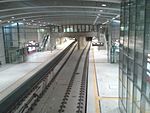Basilica of St. Severin, Cologne
4th-century churchesBasilica churches in GermanyEurope Roman Catholic church stubsGerman church stubsInnenstadt, Cologne ... and 3 more
North Rhine-Westphalia building and structure stubsRoman Catholic churches in CologneRomanesque architecture in Germany

The Basilica of St. Severin (German: Basilika St. Severin, German pronunciation: [ˌzaŋt ˈzeːvəˌʁiːn], Colognian pronunciation: [ˌtsɪnt ˈfʁɪŋs]) is an early Romanesque basilica church located in the Südstadt of Cologne (Köln). The former collegiate church is dedicated to St. Severin of Cologne. It is one of the twelve Romanesque churches of Cologne.St. Severin was established in the late 4th century as a memorial chapel and extended several times. The oldest parts of today's building date back to the 10th century. It was designated a Basilica Minor by Pope Pius XII in 1953.
Excerpt from the Wikipedia article Basilica of St. Severin, Cologne (License: CC BY-SA 3.0, Authors, Images).Basilica of St. Severin, Cologne
An der Basilika St. Severin, Cologne Altstadt-Süd (Innenstadt)
Geographical coordinates (GPS) Address External links Nearby Places Show on map
Geographical coordinates (GPS)
| Latitude | Longitude |
|---|---|
| N 50.923611111111 ° | E 6.9597222222222 ° |
Address
St. Severin
An der Basilika St. Severin 1
50678 Cologne, Altstadt-Süd (Innenstadt)
North Rhine-Westphalia, Germany
Open on Google Maps









